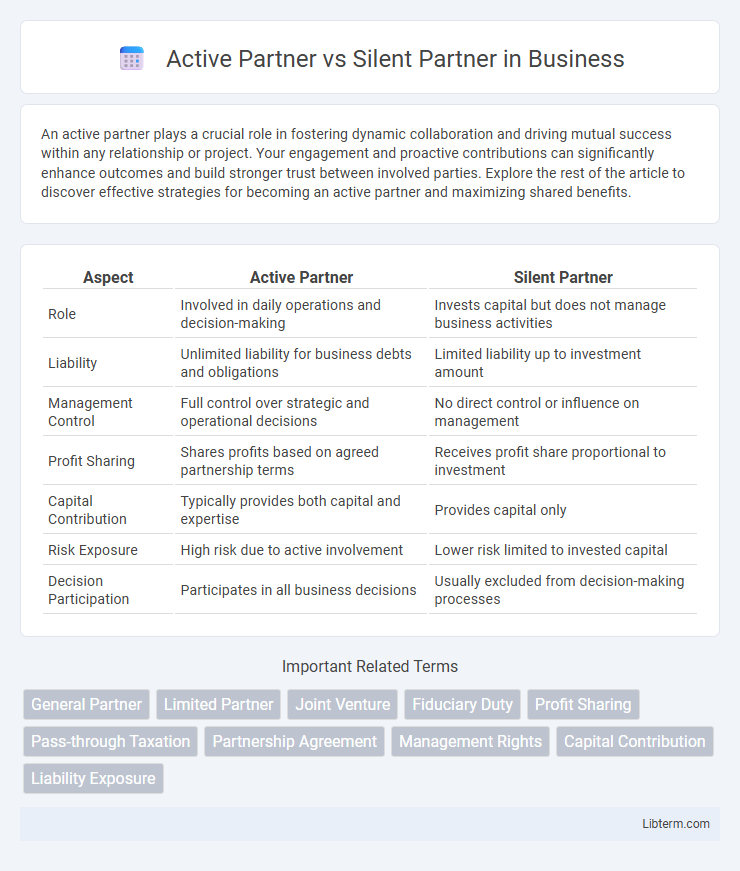An active partner plays a crucial role in fostering dynamic collaboration and driving mutual success within any relationship or project. Your engagement and proactive contributions can significantly enhance outcomes and build stronger trust between involved parties. Explore the rest of the article to discover effective strategies for becoming an active partner and maximizing shared benefits.
Table of Comparison
| Aspect | Active Partner | Silent Partner |
|---|---|---|
| Role | Involved in daily operations and decision-making | Invests capital but does not manage business activities |
| Liability | Unlimited liability for business debts and obligations | Limited liability up to investment amount |
| Management Control | Full control over strategic and operational decisions | No direct control or influence on management |
| Profit Sharing | Shares profits based on agreed partnership terms | Receives profit share proportional to investment |
| Capital Contribution | Typically provides both capital and expertise | Provides capital only |
| Risk Exposure | High risk due to active involvement | Lower risk limited to invested capital |
| Decision Participation | Participates in all business decisions | Usually excluded from decision-making processes |
Understanding the Roles: Active Partner vs Silent Partner
Active partners engage directly in daily business operations, making decisions and managing company affairs, which requires accountability and hands-on involvement. Silent partners invest capital without participating in management, limiting their liability to their investment while receiving a share of the profits. Understanding these distinct roles is crucial for defining responsibilities, financial risk, and legal obligations within a partnership.
Key Responsibilities of an Active Partner
An Active Partner in a business assumes responsibility for daily management, decision-making, and operational oversight, ensuring the company's strategic goals are effectively implemented. They contribute capital while actively engaging in tasks such as client relations, marketing, and financial planning. Unlike Silent Partners, Active Partners bear liability and are directly accountable for the partnership's performance and legal obligations.
The Role and Influence of a Silent Partner
A silent partner in a business invests capital without participating in daily operations or decision-making, offering financial support while maintaining limited liability. Their influence often shapes long-term strategy through financial input and voting rights in major decisions, despite lacking a public or managerial role. The presence of a silent partner can enhance a company's stability and creditworthiness, enabling active partners to focus on operational growth and management.
Financial Contributions: Comparing Active and Silent Partners
Active partners contribute capital while also managing daily operations and business decisions, ensuring their financial input directly influences company growth and profitability. Silent partners provide capital without involvement in management, relying on the active partners to utilize their investment effectively and share profits accordingly. The financial contributions of active partners often exceed those of silent partners, reflecting their dual role in both investment and operational responsibility.
Decision-Making Authority in Partnerships
An active partner holds significant decision-making authority, participating directly in managing business operations and strategic planning. In contrast, a silent partner typically contributes capital without involvement in daily decisions or management, limiting their influence on business policies. The distinction in decision-making authority impacts liability, responsibility, and profit-sharing frameworks within partnerships.
Legal Implications for Active and Silent Partners
Active partners have legal obligations to participate in management and bear unlimited liability for the partnership's debts and obligations, making them personally responsible for any legal actions against the business. Silent partners contribute capital but typically do not engage in day-to-day operations or management decisions, which limits their liability to the extent of their investment, shielding their personal assets from business liabilities. The partnership agreement often dictates the extent of legal responsibilities and protections for both active and silent partners, highlighting the importance of clearly defined roles to manage risks.
Advantages of Having an Active Partner
Having an active partner ensures continuous involvement in daily operations, improving decision-making and responsiveness to business challenges. Active partners contribute diverse skills and expertise, fostering innovation and effective problem-solving. Their hands-on approach also strengthens accountability and drives consistent progress towards business goals.
Benefits of Involving a Silent Partner
Involving a silent partner provides businesses with access to additional capital without requiring them to manage daily operations, allowing active partners to focus on growth and strategy. Silent partners offer financial backing and share in profits while maintaining limited liability, reducing personal risk exposure. This division of roles ensures operational efficiency and financial stability, fostering a balanced partnership dynamic.
Potential Challenges in Active and Silent Partnerships
Active partners face challenges such as managing daily operations, resolving conflicts, and bearing the burden of decision-making, which can lead to stress and burnout. Silent partners may encounter difficulties related to lack of control, limited access to business information, and potential disputes over profit sharing and liability. Both types of partnerships require clear agreements to mitigate misunderstandings and ensure smooth collaboration.
Choosing the Right Partner Structure for Your Business
Choosing the right partner structure for your business depends on the desired level of involvement and decision-making authority, with an active partner engaging in daily operations and strategy while a silent partner provides capital without influencing management. Active partners contribute skills and labor, enhancing business growth and accountability, whereas silent partners help reduce financial risk and allow active partners to maintain control. Evaluating your business needs and goals ensures selecting a partner structure that optimizes collaboration, resource allocation, and long-term success.
Active Partner Infographic

 libterm.com
libterm.com